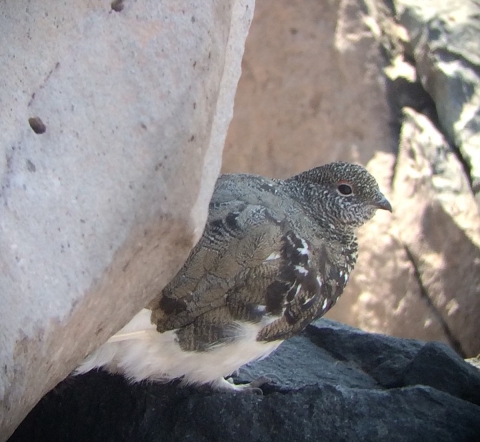Ptarmigan (pronounced Taar-muh-gn) are small grouse regally adapted to cold, snowy winter climates of the arctic and alpine. They turn all-white in the winter and blend in perfectly in fields of snow. Their white feathers are well-insulated and they are adapted to live in cold temperatures. They have feathered feet, which act like snowshoes. The scientific name for this genus of birds, Lagopus, actually means hare-foot, as in snowshoe hare.
Throughout the world, only three species of ptarmigan exist, and they are all found in the arctic or alpine areas of the Northern Hemisphere. In Washington, we have only one of these three species: the white-tailed ptarmigan (Lagopus leucura). This Mount Rainier subspecies of white-tailed ptarmigan is found only in Washington and British Columbia south of the Fraser River Valley. Rock ptarmigan (Lagopus muta) are found close by, and have been observed as close as the Washington-Canada border. Unlike many winter residents of alpine and arctic areas, ptarmigan don’t need a high-energy fatty diet to sustain them through the cold winters. The adults are strictly vegetarian, eating the tips of shrubs protruding through the snow in winter. White-tailed ptarmigan have a low metabolism, which means it does not take much food to power them through harsh winters. Studies in Colorado show they even gain weight over the winter on their diet of shrubs. When the air temperature is harsh, they dig comfortably into the snow, because snow is great insulation, and it protects them from wind chill.
White-tailed ptarmigan have been studied extensively in Colorado, and studies have also been conducted in Vancouver Island, Alaska, and in the Sierra Nevada Mountains of California (where they were introduced for hunting purposes.)
Yet, in Washington we know very little about where they occur, what they eat, and how (or if) they need different winter habitat than in other areas of their range. Scientists have not conducted any studies on Washington’s white-tailed ptarmigan in winter. We know in Colorado they seek out stands of willow protruding just high enough above the snow for them to reach. We know in the Yukon they are relegated to higher, more windswept areas, as a result of competition with rock and willow ptarmigan. Yet, we have so much snow in Washington (the deepest snow records in the U.S. are at Mount Rainier and Mount Baker), scientists aren’t sure where these birds can even get to willow, alder, or birch in winter, because it may all be buried in many feet of snow. It can’t all be buried, or we wouldn’t have any white-tailed ptarmigan left. Are the populations declining? No one knows.
That’s where skiers and snowshoers can help. We need you to tell us where you see these birds. If you see an all-white grouse in winter, take a picture of the birds (it will probably be a flock), a picture of the area you are in, record your location, date, time, and a description of the area you found it. If you are near the Canadian border, take a picture, or at least notes, of the tail, so we know if it is a white-tailed ptarmigan or rock ptarmigan. Report your observation on ebird, inaturalist, Washington Dept. of Fish and Wildlife’s “Report Wildlife Observations”, or report it to us at the U.S. Fish and Wildlife Service (Email WFWO_LR@fws.gov). Once we know more basic information about where they occur, scientists can start designing studies to monitor their populations and habitat. We need you to help us start.



